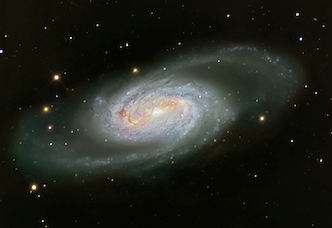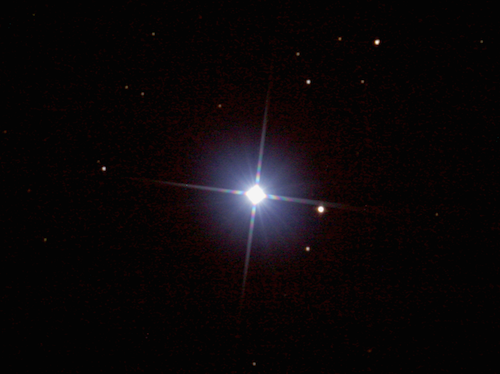Regulus [Alpha (α) Leonis] marks the handle end of the Sickle asterism. Nicolas Copernicus is credited with naming this star Regulus, meaning “Little King” in Latin, although he was not the first to refer to it as kingly. Many ancient cultures — including the Arabians, Babylonians, and the Akkadians of Mesopotamia — also viewed it as celestial royalty.
Regulus is a quadruple-star system. The bright star we see is a blue-white, spectral type B main sequence star, orbited by a white dwarf companion that has never been observed directly. Through binoculars, however, we can see the system’s third member, an 8th-magnitude point nearly 3′ from the brilliant primary sun if the latter is moved out of the field. This star is itself a binary system, but seeing its companion is restricted to large amateur telescopes.
One reason for that is its location, only about 6° west of Regulus and just south of 19 Leonis. Over the course of 312 days, R Leonis fluctuates from magnitude 5.8 to 10.0, and back again. That’s bright enough to watch through most binoculars across its full cycle.
It’s fun to trace the changes in brightness over several weeks and months. By comparing its brightness to that of nearby stars that don’t vary, you can create your own light curve, which plots the changes in brightness over time. To do that, you’ll need an accurate chart of the area. You can create your own using the AAVSO’s online Variable Star Plotter at www.aavso.org/apps/vsp.
Right now, R Leonis is on a downward slide, having reached peak brightness in February. But thanks to its bright range and strong reddish glow, R Leonis is sure to become one of your seasonal favorites. R Leo will remain visible in the evening until early June and then return to the early morning sky by mid-September.
The barred spiral galaxy NGC 2903 is one of the brightest and largest galaxies in the spring sky. Yet Messier and his contemporaries missed it, even though it would have been visible in their telescopes. Instead, its discovery was left to William Herschel, who first spotted it November 16, 1784.
To find NGC 2903, trace the Sickle to Epsilon (ε) Leonis at the “tip,” and then glance west with your binoculars to 4th-magnitude Lambda (λ) Leonis. Centering on Lambda, shift your attention 1.5°, or about a quarter of a field, due south. Can you make out a faint oval disk of grayish light highlighted by a brighter central core? That’s the galaxy.
Finally this month, we leave Leo behind and head north to his little brother, Leo Minor. While there isn’t much to see here by eye or binoculars, we do have one port of call that makes a fun diversion. In 1988, Ohio amateur astronomer Dan Hudak wrote a letter that appeared in that summer’s issue of Deep Sky magazine, describing an asterism measuring about half a degree across that looked like a celestial sailboat. Although he found the Sailboat using a telescope, it’s also faintly visible through binoculars.
Begin at Mu (μ) Leonis, the northern point of Leo’s Sickle. Scan northeastward for 7°, crossing Leo and Leo Minor’s shared border, until you arrive at 6th-magnitude 22 Leonis Minoris. That star marks the boat’s bow. Four 7th- and 8th-magnitude stars in a trapezoid west of 22 LMi outline the deck and hull, while 8th-magnitude SAO 61926 marks the stern. The tall mast is formed by three stars, ending at SAO 61951. Be aware that through binoculars, the Sailboat seems to have capsized, as its mast points toward the south.
I’d enjoy hearing about your favorite binocular objects, and possibly featuring them in future columns. Contact me through my website, philharrington.net. Until next month, remember that two eyes are better than one.












